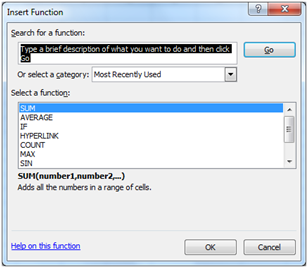The Quick Access Toolbar is located to the right of the Microsoft Office Symbol and Above the Home Tab.
Right out of the box, initial install, there are three buttons by default; Save, Undo, and Redo. If you want to you can add buttons or remove buttons from the Quick Access Tool Bar. There are a few of ways that we can do this.
The Quick Access Toolbar Button
To the right of the Quick Access Toolbar there is a symbol that looks like a line above a triangle that is pointing down, this is actually a button.When you press the button a dialog box appears. With this dialog box you can add or remove buttons from a standard list. As you can see there are some that have a check-mark to the left of them. These are the buttons that will show in the Quick Access Toolbar.
To add more buttons just click on the word, for instance New, This will add the New Spreadsheet Button to the Quick Access Toolbar; the Dialog Box will close after you click. If you want to add more of the predefined buttons then you can repeat the same steps as often as you want.
To remove the button from the list, simply click on the name of the button that you wish to remove from the Quick Access Toolbar and the check-mark will be removed, the Dialog Box will close, and it will remove the button from the Quick Access Toolbar.
There are three other buttons on the Customize Quick Access Toolbar; they are More Commands, Show Below the Ribbon, and Minimize the Ribbon.
More Commands
The More Commands Button will open another Dialog Box; this dialog box has many options forcustomizing Microsoft Excel. I will talk about most of them later on in the book. For now I will discuss
the Customize the Quick Access Toolbar, in the Customize Section.
This Dialog Box is split into many parts; On the right side we have a list of sections that we can
access, there is the Choose commands from drop down, below that we have the command buttons for
that particular command group. Below that we have the Show Quick Access Button Below the Ribbon
check box. Next we have the Add and Remove Buttons. Then the Customize Quick Access Toolbar drop
down, here we can choose if we want to apply the changes in the Quick Access Toolbar to all Documents
or just this particular Spreadsheet. Below that we have a list of the buttons that will appear in the Quick
Access Toolbar. Then we have the Reset Button which will reset the Quick Access Toolbar to the default
settings. The Modify Button applies to special buttons that you can create for Macros, we will talk about
these later. To the right of the button list there are two buttons that we can use to change the order of
the buttons on the Quick Access Toolbar, the closer the button is to the top of the list the closer to the
Office Symbol it will be. We then have the OK and Cancel buttons. If we made changes to the list we
need to click the OK button for those changes to take effect, if we use the Cancel button it will not keep
the changes that we have just made.
Add a Quick Access Button from a Group
There is another way to add a button to the Quick Access Toolbar using the right mouse button.If you want to add the Insert Picture Button, go to the Insert Tab, right mouse click on the Picture Icon
and click the Add to Quick Access Toolbar.
Show Below the Ribbon
The Show Below the Ribbon, option will move the Quick Access Toolbar from the default location to bellow the ribbon. When you do not know that this is a feature and someone has moved the Quick Access Toolbar it is hard to find. I know because before I realized that this was an option it happened to me.When the Quick Access Toolbar is below the Ribbon the choice changes to Show Above the Ribbon.
Minimize the Ribbon
The Minimize the Ribbon is another option that Microsoft has given. When you use this optionthe Workbook area becomes larger. This is an option that Microsoft did not advertize. I learned about
this option when I was told that I was going to be sowing others how to use Microsoft Office 2007.
There was no training that neither I nor my boss received.
The program was installed on one computer in my classroom; someone had accidentally removed the Ribbon before either of us had seen the new program. It took awhile but my boss figured it out and informed me as to how to fix it.
To Minimize the Ribbon with the control button, click the Button and then click on the last choice, Minimize the Ribbon. See the picture to the right. With the Ribbon Minimized to see the groups on the ribbon just click on the tab name such as Home, Insert, Page Layout, etc…
To maximize the Ribbon you can click on the Quick Access Toolbar Button again and uncheck the Minimize the Ribbon. This will restore the Ribbon to its original state.






![Validate my Atom 1.0 feed [Valid Atom 1.0]](valid-atom.png)